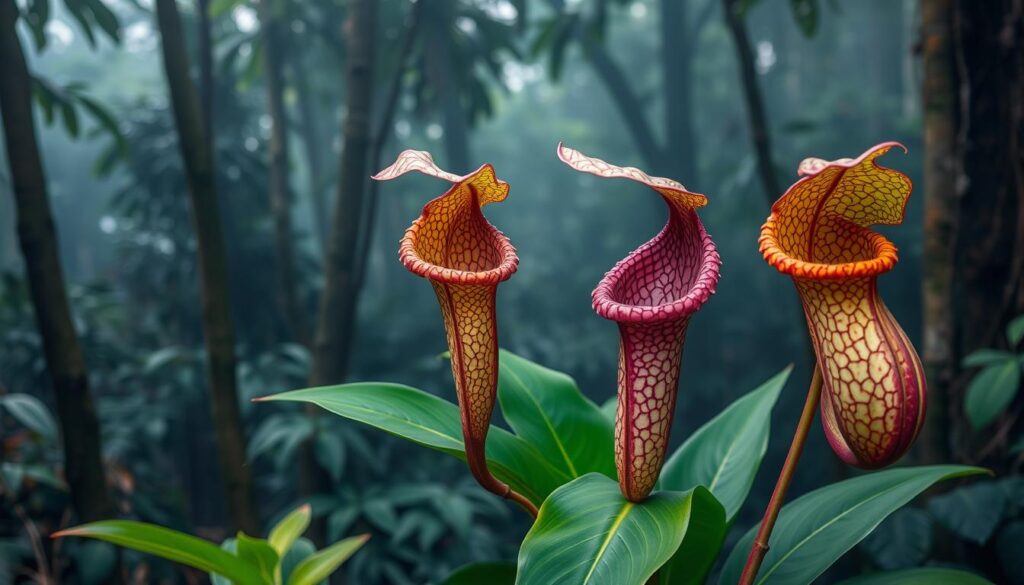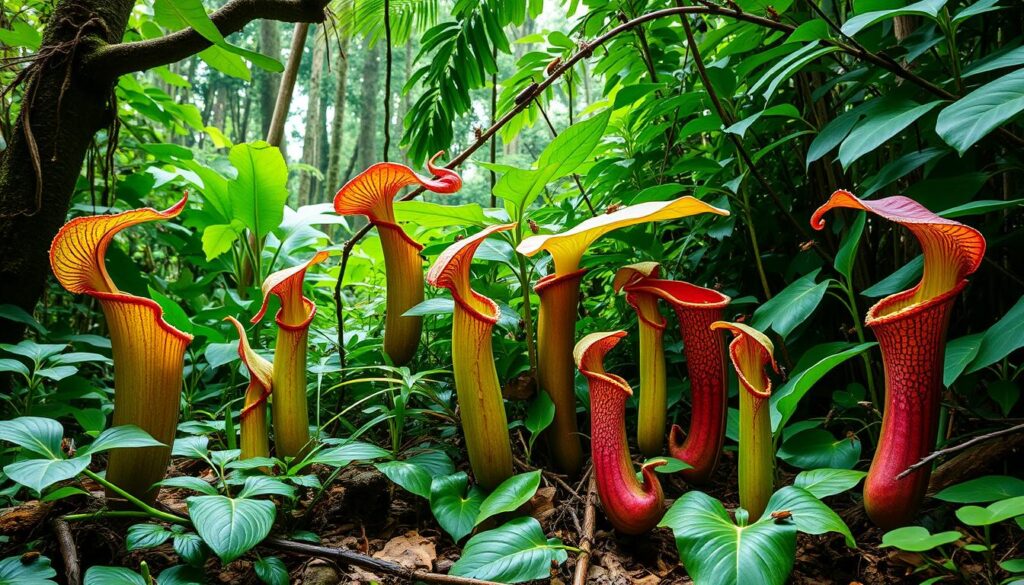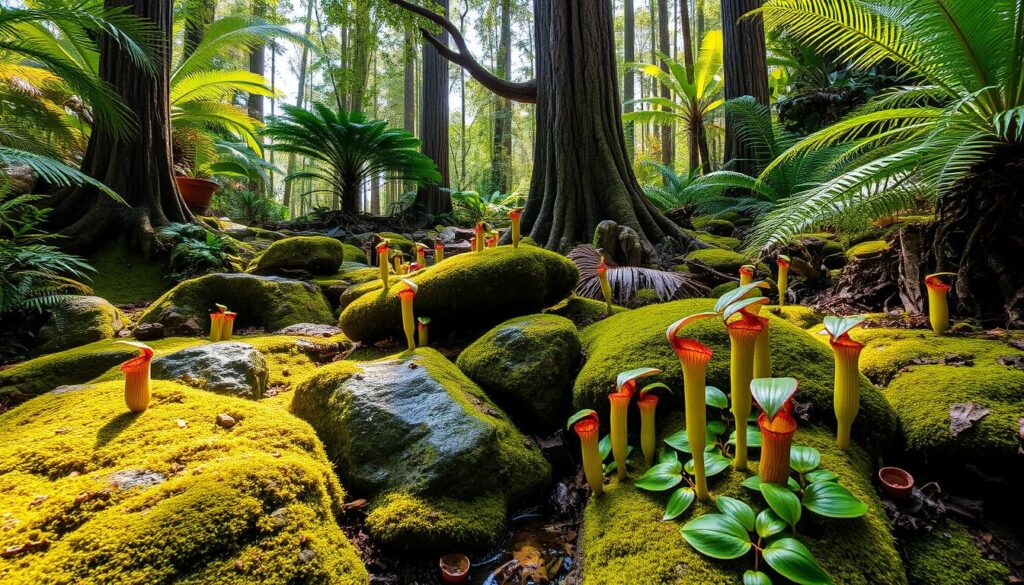Pitcher plants are amazing plants that eat insects to get nutrients. They are part of a big group of carnivorous plants, with over 600 types found around the world. In South Carolina, there are about 31 types of these plants, making them a big deal in the ecosystem.
South Carolina has 76 special places for these plants, covering almost 100,000 acres. These places help keep the plants safe from harm. Learning about pitcher plants can make us appreciate their unique role in nature.
Pitcher plants have special leaves that look like cups and bristles that point down. These features help them catch insects. By understanding these plants, we can see how amazing nature is and why we need to protect it.
Table of Contents
Understanding the Fascinating World of Pitcher Plants
Pitcher plants are part of a group of carnivorous plants. They get nutrients by catching and digesting insects. Their leaves are shaped like cups, helping them grow in poor soil. The pitcher plant diet mainly includes insects, which get trapped and digested by the plant.
The evolution of carnivorous plant adaptations is really interesting. These plants have developed ways to catch and digest prey. Some can even catch small frogs, birds, and rodents.
What Makes Pitcher Plants Unique
Pitcher plants stand out because of their special features. These include:
- Modified leaves that form a cup-shaped trap
- A slippery surface that prevents insects from escaping
- Digestive enzymes that break down the insect’s body
The Evolution of Carnivorous Plants
Carnivorous plants have evolved over millions of years. They live in places like bogs, marshes, and forests. Their adaptations help them survive in poor soil.
Different Types of Pitcher Plants
There are many types of pitcher plants, each unique. Some common ones include:
| Type of Pitcher Plant | Description |
|---|---|
| Sarracenia | A type of pitcher plant found in North America, known for its tall, slender leaves |
| Nepenthes | A type of pitcher plant found in Asia, known for its large, cup-shaped leaves |
| Cephalotus | A type of pitcher plant found in Australia, known for its small, cup-shaped leaves |
Learning about pitcher plants helps us appreciate their unique features. By understanding their pitcher plant diet and carnivorous plant adaptations, we can value nature more. This knowledge also supports conservation efforts.
Fun Facts About Pitcher Plants That Will Amaze You
Pitcher plants are fascinating plants that live in poor soil. There are many types of pitcher plants, like the Nepenthes rajah, known as the king. They grow in bogs, swamps, and rocky places. You can find them in North America, Asia, and Australia.
Some cool facts about pitcher plants are:
- They get nutrients by catching and breaking down other living things, not from soil.
- They like acidic soil, with a pH of 3.0 to 5.0.
- They need a special soil mix, like 50% sand and 50% peat moss, to grow well.
In their natural pitcher plant habitat, they catch insects to get nutrients. Knowing about types of pitcher plants helps us care for them better.
The Remarkable Anatomy of Pitcher Plants
Pitcher plants have evolved special traits to catch and digest insects. They can make digestive enzymes to break down insects. This process gives them the nutrients they need.
The pitcher trap’s structure is a marvel of evolution. It has a cup-shaped leaf filled with water and digestive enzymes. This setup helps pitcher plants grow well in poor soil, where others might not survive.
The Structure of the Pitcher Trap
The pitcher trap is made up of several parts. These include:
- A deep, cup-shaped leaf that forms the pitcher
- A pool of water and digestive enzymes at the bottom of the pitcher
- A slippery surface that prevents insects from escaping
Together, these parts make a trap that catches many insects.
How Pitcher Plants Produce Digestive Enzymes
Pitcher plants make digestive enzymes in their leaves. These enzymes are then released into the pitcher trap. They break down insects into a nutrient-rich soup that the plant can absorb. This is key for the plant’s survival, as it gets the nutrients it needs to grow.
Some pitcher plants have special relationships with other creatures. For example, the Nepenthes lowii attracts tree shrews. These shrews bring nitrates and other nutrients through their feces. This shows how complex and interesting the world of pitcher plants is.
| Pitcher Plant Species | Unique Characteristics |
|---|---|
| Nepenthes lowii | Attracts tree shrews, which provide nitrates and other nutrients |
| Nepenthes rafflesiana var. elongata | Has an elongated pitcher shape that accommodates bats and other small mammals |
Nepenthes Raja: The King of Pitcher Plants
Nepenthes Raja, known as the king of pitcher plants, grows in Borneo’s mountains. It’s one of the biggest pitcher plants. It can catch and digest big insects, like frogs and small rodents. Fun facts about pitcher plants show they get nutrients by eating insects.
Some interesting facts about pitcher plants reveal their special animal friends. For instance, Nepenthes Raja draws mountain tree shrews with lots of nectar. This nectar also helps the soil around the plant by adding nutrient-rich manure. This shows how pitcher plants have amazing adaptations.

- Maximum pitcher height: up to 41 cm
- Maximum pitcher width: up to 20 cm
- Capacity of the pitcher: can hold 3.5 L of water and over 2.5 L of digestive fluid
Nepenthes Raja stands out as one of the most impressive pitcher plants. Its big pitchers and special features make it unique.
The Hunting Strategies of Pitcher Plants
Pitcher plants have evolved unique ways to catch and digest insects. These plants use nectar and other attractants to lure insects into their leaves. Once inside, the insects are trapped and digested by enzymes.
The carnivorous plant adaptations of pitcher plants are fascinating. Different species have developed unique structures to capture and retain prey. For example, some have bristles that let insects in but make it hard for them to get out.
Some interesting facts about pitcher plants include:
- They can capture and digest a wide range of prey, from small insects to larger animals like reptiles and small mammals.
- Some species of pitcher plants can grow up to 1.5 meters tall and produce pitchers with a diameter of 30 centimeters.
- The digestive fluid of large pitcher plants can contain vertebrates and small mammals.
Pitcher plants are found on every continent except Antarctica. Their unique adaptations have allowed them to thrive in various environments. By understanding their hunting strategies, we can appreciate the complex and fascinating world of carnivorous plants.
| Species | Prey | Unique Adaptations |
|---|---|---|
| Nepenthes attenboroughii | Reptiles and small mammals | Inward-pointing bristles |
| Nepenthes rajah | Small mammals and insects | Large pitchers with a diameter of up to 30 centimeters |
Native Habitats and Global Distribution
Pitcher plants live in many places worldwide, like bogs, swamps, and rocky spots. The types of pitcher plants that do well in these areas are made for poor soil. They can be found in different pitcher plant habitat types.
Green pitcher plants can grow quite tall, up to 3 feet, and wide, up to 6 inches. They need soil with a pH between 3.5 and 5.5. Also, they grow best in temperatures between 65°F and 85°F.
Pitcher plants are found in North America, Asia, and Australia. They live in various places, from wet areas to dry spots in spring and summer. Here are some key things about where pitcher plants live:
- Low-nutrient soils
- Acidic pH levels
- Full sun exposure
- Ability to endure dry conditions
Pitcher plants are really interesting, with over 140 kinds. They live in both warm and cool places. They have special ways to survive and grow.
| Pitcher Plant Species | Native Habitat | Soil Requirements |
|---|---|---|
| American Pitcher Plant | North America | Acidic pH, low-nutrient soil |
| Tropical Pitcher Plant | Tropical regions | High humidity, acidic pH |
Conservation Status and Rarity in the Wild
Pitcher plants face many threats in the wild. These include habitat loss, pollution, and over-collection. Their unique way of getting nutrients by eating insects makes them both interesting and at risk. Some pitcher plants, like the Sarracenia leucophylla, are very rare. They can only be found in a few places along the Gulf Coast of North America.
Habitat destruction is a big threat to pitcher plants. This is due to human activities like development, agriculture, and logging. The cut flower trade also harms them, as it can cause plants to starve and die. Places like the Atlanta Botanical Garden are working to save these plants. They do this by protecting their habitats, collecting seeds, and reintroducing plants to their old homes.
- The Atlanta Botanical Garden’s efforts to safeguard the genetic diversity of Sarracenia leucophylla
- The reintroduction of fires into the ecology of wetland systems to restore integrity and resiliency
- The collection of seeds from Southern Appalachian purple pitcher plants by the North Carolina Botanical Garden
The conservation status of pitcher plants varies. Some, like the Southern Appalachian purple pitcher plant, are endangered. International trade is watched closely because of their threatened status. Conservationists are working hard to protect these unique and fascinating plants.
| Pitcher Plant Species | Conservation Status | Threats |
|---|---|---|
| Sarracenia leucophylla | Endangered | Habitat loss, over-collection |
| Southern Appalachian purple pitcher plant | Endangered | Habitat loss, pollution |
Amazing Adaptations for Survival
Pitcher plants have developed amazing adaptations to live in places with little nutrients. One cool fact is how they catch and eat insects. This gives them the nutrients they need. Their cup-shaped leaves trap insects, who then can’t get out.
Some fun facts about pitcher plants are how they grow well in poor soil. They like soil that’s very acidic, with a pH between 3.0 and 5.0. They also need lots of sunlight to stay colorful. The right soil moisture and a warm place to start growing are key.

Pitcher plants also have clever ways to draw in insects. They use sweet nectar, smells, and colors to attract them. With about 10 types of Sarracenia, these plants are a big interest for scientists and nature fans.
Pitcher Plants in Traditional Medicine and Culture
Pitcher plants have been used in traditional medicine for centuries. Their carnivorous plant adaptations make them interesting. The pitcher plant diet includes insects, which are essential for the plant’s survival.
Green pitcher plants can grow well in poor soils. They are great for bog gardens and indoor terrariums. They need mildly acidic soil and enough sunlight to thrive.
Pitcher plants have been used to treat fever and rheumatism. Today, they are used in horticulture and conservation efforts.
Historical Uses and Beliefs
Pitcher plants have been used in traditional medicine for centuries. They have unique properties that make them valuable. Some historical uses include:
- Treating fever and rheumatism
- Using the plant’s leaves and roots for medicinal purposes
- Believing in the plant’s ability to ward off evil spirits
Modern Applications
Today, pitcher plants are used in various ways, including:
- Horticulture: They are popular among gardeners and plant enthusiasts for their unique look and easy care.
- Conservation: Efforts are being made to save pitcher plant species and their habitats, like creating bog gardens and indoor terrariums.
In conclusion, pitcher plants have a rich history in traditional medicine and culture. Their unique carnivorous plant adaptations make them valuable. By understanding their diet and role in traditional medicine, we can see why it’s important to conserve them and their habitats.
Growing Pitcher Plants: From Wilderness to Garden
Pitcher plants are fascinating carnivorous plants that can thrive in greenhouses and indoor gardens. They need high humidity and full sun to partial shade to grow well. There are over 100 species worldwide, with about 10 found in the United States.
The pitcher plant habitat is usually warm and wet, like bogs and swamplands. But, with the right care, they can also do well in gardens. The Nepenthes rajah is a favorite among collectors, known as the king of pitcher plants. Here’s what you need to know to grow them:
- Provide high humidity, ideally above 50%
- Offer full sun to partial shade, depending on the species
- Use a well-draining potting mix to prevent root rot
- Water with distilled or rainwater to prevent mineral buildup

| Species | Habitat | Growing Conditions |
|---|---|---|
| Nepenthes rajah | Tropical forests | High humidity, full sun to partial shade |
| Sarracenia oreophila | Bogs and swamplands | High humidity, full sun to partial shade |
Scientific Discoveries and Ongoing Research
Scientists have made big strides in understanding pitcher plants. They’ve found new species, like Nepenthes pudica, which catches prey underground. This shows how diverse pitcher plants can be. They’ve also looked into how these plants trap prey, thanks to their slippery surfaces and special traps.
Research on pitcher plants has also led to new tech ideas. For example, they’ve inspired the creation of droplet-based fluidic devices. Plus, finding new species and studying their homes has shown us why we must protect rainforests. Some key findings include:
- Pitcher plants live in tropical areas, mainly in Southeast Asia. They thrive in places with little nitrogen, like mountain slopes and swamps.
- The shape of the plant’s rim and peristome shapes matter a lot. They help decide what kind of prey gets caught.
- Studies have shown that pitcher plants have evolved to catch specific prey. This is true for different habitats.
Overall, research on pitcher plants has grown our knowledge of these fascinating plants. It has also shown their vital role in ecosystems and their possible uses in technology.
Frequently Asked Question
What are some interesting facts about pitcher plants?
Pitcher plants are fascinating carnivorous plants known for their unique, vase-shaped leaves that trap and digest insects. They thrive in nutrient-poor soils by supplementing their diet with prey. Their “pitchers” are often brightly colored and emit a sweet scent to lure insects. Some species even trap small frogs or mice! Pitcher plants use a slippery inner surface to ensure prey can’t escape, making them true masters of survival.
What Is the King of the Pitcher Plant?
The Nepenthes rajah is often called the “king” of pitcher plants. Found in Borneo, this giant species has the largest pitchers, sometimes big enough to trap small mammals! It’s a marvel of nature and one of the most iconic carnivorous plants.
What Happens If I Put My Finger in a Pitcher Plant?
Nothing serious! While the liquid inside is acidic and contains digestive enzymes, it won’t harm your skin. You might feel some stickiness or mild irritation, but it’s more of a curiosity than a danger to humans.
Do Pitcher Plants Have Teeth?
Not really! Some species have ridges or “fangs” around their rims, but they aren’t true teeth. These features help guide insects into the pitcher or prevent them from escaping.
How Long Can a Pitcher Plant Live?
Pitcher plants can live up to 20 years if cared for properly. In the wild, their lifespan depends on the environment, but many thrive for decades.
Are Pitcher Plants Toxic to Cats?
No, pitcher plants are not toxic to cats. However, curious cats might play with them, which could damage the plant or mildly irritate the cat’s paws or mouth. Supervision is always a good idea!

